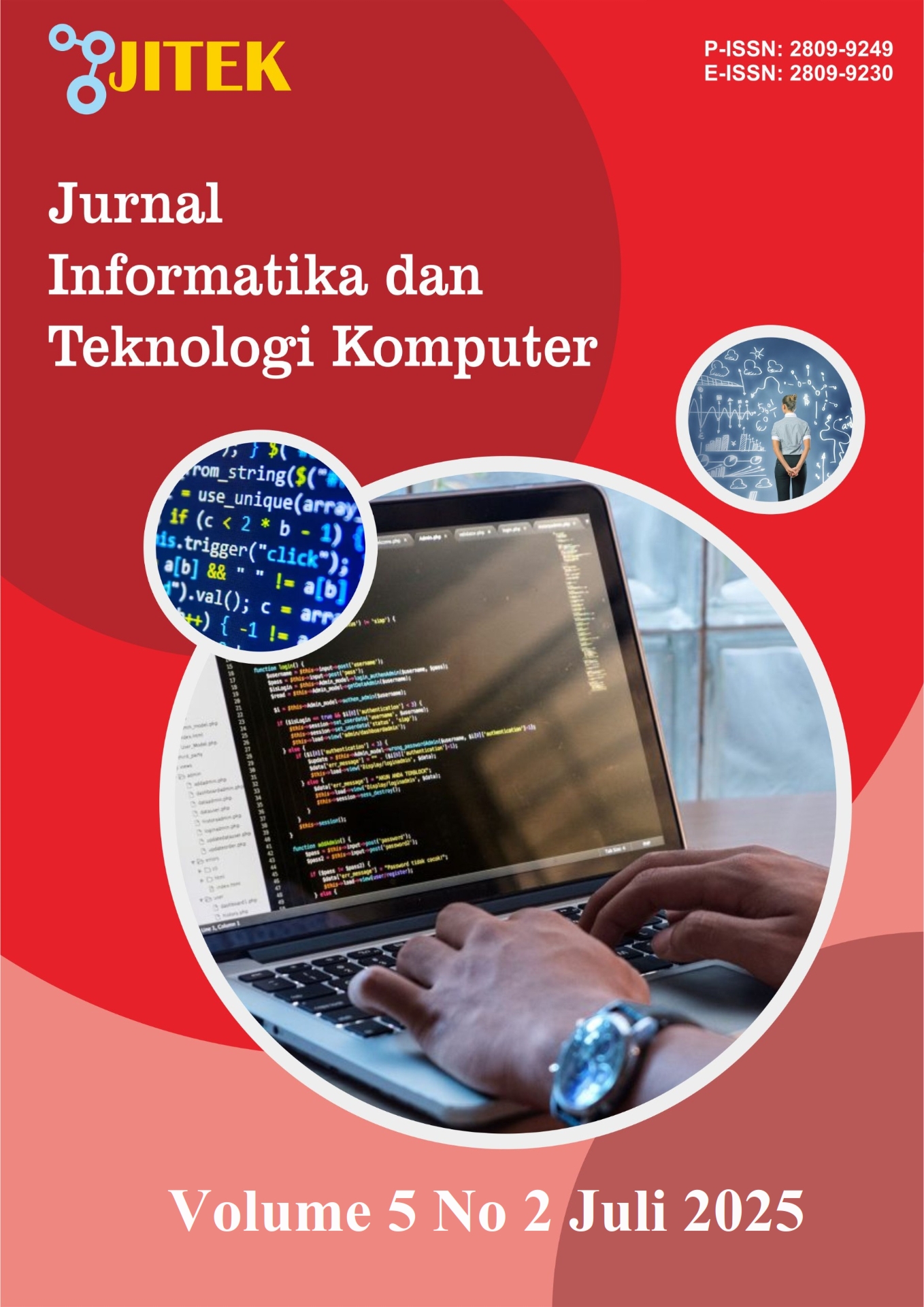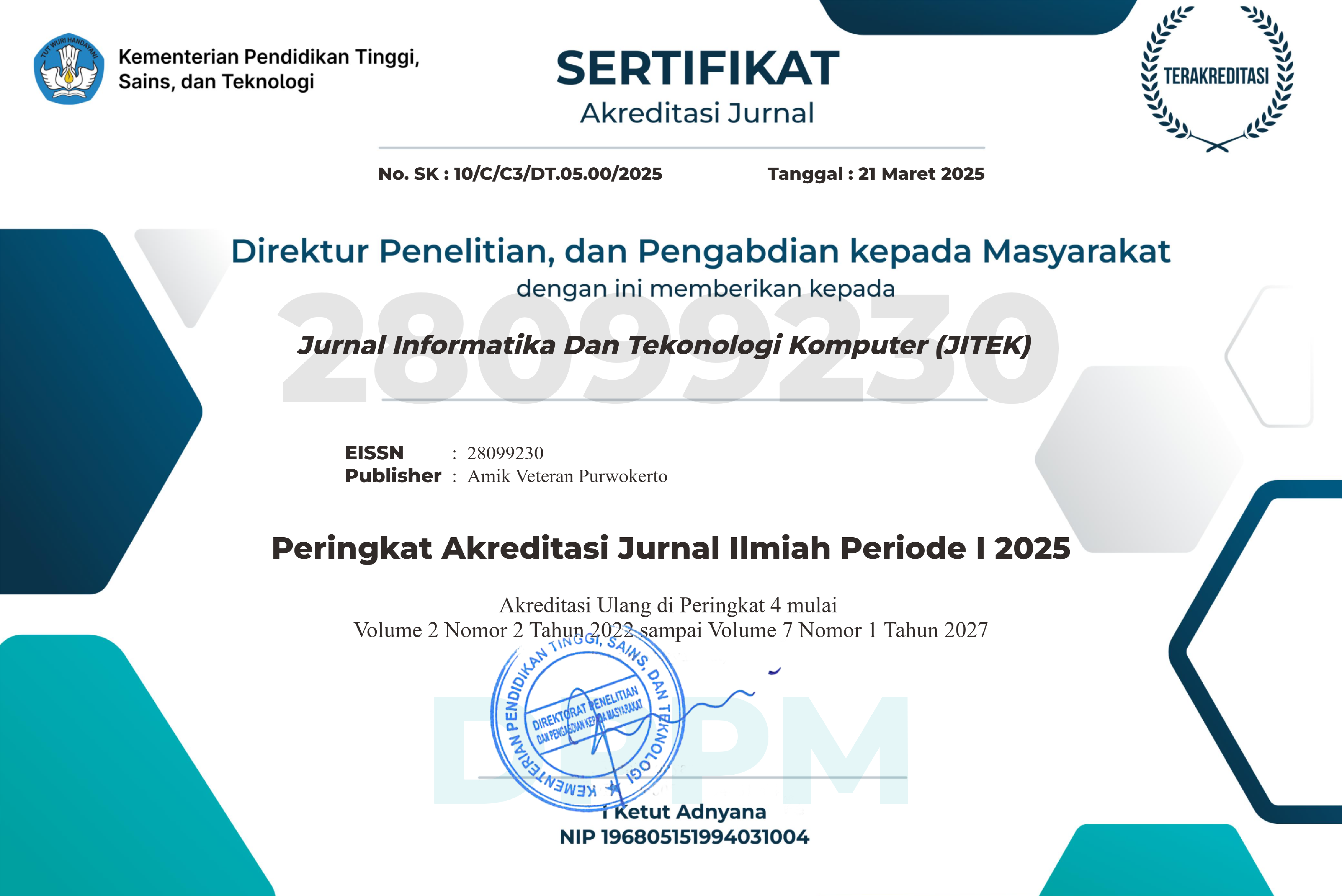Penerapan Algoritma K-Means Untuk Menganalisis Berdasarkan Jenis Dan Penyebab Kematian Di Jawa Barat
DOI:
https://doi.org/10.55606/jitek.v5i2.7148Keywords:
West Java Province, clustering, K-Means, Metode Elbow, Data miningAbstract
West Java Province is one of the regions in Indonesia with fluctuating mortality rates each year. The high number of deaths in various areas, with diverse characteristics of death types and causes, encourages the need for in-depth analysis to map the pattern of mortality cases. This study aims to analyze mortality data in West Java Province based on the type of death, cause of death, and number of cases using the K-Means Clustering method. The data used in this study is secondary data obtained from the official Open Data Jawa Barat portal for the period 2019 to 2023, with a total of 506 mortality records that have undergone pre-processing and data transformation stages. The analysis process was carried out through clustering using the K-Means algorithm, with the optimal number of clusters determined by the Elbow Method, and the clustering quality evaluated using the Silhouette Score. The results showed that the mortality data could be grouped into three main clusters, each with different characteristics in terms of the number of deaths, types, and causes. Cluster 0 consists of data with a high number of deaths, mostly occurring in urban areas. Cluster 1 contains data with moderate numbers and a variety of causes, while Cluster 2 represents areas with low mortality rates spread across several districts. The obtained Silhouette Score value of 0.52 indicates that the quality of cluster separation is quite good. In addition to clustering results, data visualization showed that Dengue Fever has been the dominant cause of death in the last three years, with Cianjur Regency recorded as the region with the highest mortality cases. This study is expected to serve as a reference for formulating public health policies and mortality prevention strategies in West Java Province.
References
[1] C. Della Evania, W. Wiyanti, and C. Author, “Perbandingan Metode Holt’s Linier dan GPT-4 untuk Peramalan Jumlah Kasus Kematian Diabetes Melitus di Indonesia,” 2024. [Online]. Available: http://www.ojs.unm.ac.id/jmathcos
[2] M. Rizqi Sulistio, N. Suarna, and O. Nurdiawan, “Analisa Penerapan Metode Clustering X-Means Dalam Pengelompokan Penjualan Barang,” Jurnal Teknologi Ilmu Komputer, vol. 1, no. 2, pp. 37–42, 2023, doi: 10.56854/jtik.v1i2.49.
[3] E. Dwiguna and A. Bahtiar, “PENERAPAN DATA MINING UNTUK MENENTUKAN PENERIMA BANTUAN BLT MENGGUNAKAN METODE CLUSTERING K-MEANS PADA DESA PAMULIHAN,” 2024.
[4] D. Setra Perdana, “PENERAPAN METODE K-MEANS CLUSTERING UNTUK MENGELOMPOKKAN KETAHANAN PANGAN,” vol. 3, no. 2, pp. 67–66.
[5] Wenny, “Bulletin of Information System Research (BIOS) Normalisasi Data Kependudukan Dengan Model Min Max Dan Algoritma K-Means Untuk Pengelompokkan Tingkat Ekonomi Masyarakat,” 2024, [Online]. Available: https://journal.grahamitra.id/index.php/bios
[6] S. Syahidatul Helma et al., “Clustering pada Data Fasilitas Pelayanan Kesehatan Kota Pekanbaru Menggunakan Algoritma K-Means,” 2019.
[7] B. G. Sudarsono, M. I. Leo, A. Santoso, and F. Hendrawan, “ANALISIS DATA MINING DATA NETFLIX MENGGUNAKAN APLIKASI RAPID MINER,” JBASE - Journal of Business and Audit Information Systems, vol. 4, no. 1, Apr. 2021, doi: 10.30813/jbase.v4i1.2729.
[8] A. Octaviani and P. Dewi, “Big Data di Perpustakaan dengan Memanfaatkan Data Mining,” ANUVA, vol. 4, no. 2, pp. 223–230, 2020.
[9] R. Kurniawan, S. Defit, and S. Sumijan, “Prediksi Tingkat Kerugian Peternak Akibat Penyakit pada Sapi Menggunakan Algoritma K-Means Clustering,” Jurnal Informasi dan Teknologi, Sep. 2020, doi: 10.37034/jidt.v3i1.87.
[10] S. D. Oleh and A. Allaam, “Prediksi Churn Konsumen Menggunakan Algoritma Random Forest dengan Fuzzy C-Means untuk Meningkatkan Produktivitas Penjualan Bisnis,” 2023.
[11] D. Sebagai et al., “PENGELOMPOKAN PRODUK BERDASARKAN DATA PERSEDIAAN BARANG MENGGUNAKAN METODE ELBOW DAN K-MEDOID TUGAS AKHIR.”
[12] A. Nursikuwagus, Suherman, and I. Alamsyah, “KLUSTERISASI PENYEBAB KEMATIAN DI INDONESIA DENGAN PENERAPAN ALGORITMA K-MEANS,” JSiI (Jurnal Sistem Informasi), vol. 11, no. 2, pp. 56–63, Sep. 2024, doi: 10.30656/jsii.v11i2.9276.
[13] F. Alghifari and D. Juardi, “Fauzan Alghifari Penerapan Data Mining Pada Penerapan Data Mining Pada Penjualan Makanan Dan Minuman Menggunakan Metode Algoritma Naïve Bayes.”
[14] T. Lidia Putri and R. Danar Dana, “PENERAPAN DATA MINING PADA CLUSTERING DATA HARGA RUMAH DKI JAKARTA MENGGUNAKAN ALGORITMAK-MEANS,” 2024. [Online]. Available: https://www.rumah123.com/jual/dki-jakarta/rumah/.
[15] D. A. Manalu and G. Gunadi, “IMPLEMENTASI METODE DATA MINING K-MEANS CLUSTERING TERHADAP DATA PEMBAYARAN TRANSAKSI MENGGUNAKAN BAHASA PEMROGRAMAN PYTHON PADA CV DIGITAL DIMENSI,” Infotech: Journal of Technology Information, vol. 8, no. 1, pp. 43–54, Jun. 2022, doi: 10.37365/jti.v8i1.131.
[16] R. Putra Primanda, A. Alwi, and D. Mustikasari, “url : http://studentjournal.umpo.ac.id/index.php/komputek DATA MINING SELEKSI SISWA BERPRESTASI UNTUK MENENTUKAN KELAS UNGGULAN MENGGUNAKAN METODE K-MEANS CLUSTERING (Studi Kasus di MTS Darul Fikri ),” 2021. [Online]. Available: http://studentjournal.umpo.ac.id/index.php/komputek
[17] M. Anggraini, R. Ayuning Tyas, I. Ana Sulasiyah, and Q. Aini, “IMPLEMENTASI ALGORITMA NAÏVE BAYES DALAM PENENTUAN RATING BUKU.” [Online]. Available: www.kaggle.com
[18] D. A. Fakhri, S. Defit, and Sumijan, “Optimalisasi Pelayanan Perpustakaan terhadap Minat Baca Menggunakan Metode K-Means Clustering,” Jurnal Informasi dan Teknologi, pp. 160–166, Sep. 2021, doi: 10.37034/jidt.v3i3.137.
[19] J. Hasil Penelitian dan Karya Ilmiah, M. Rizki, D. Devrika, F. Surayya Lubis, and I. Hadiyul Umam, “Aplikasi Data Mining dalam Penentuan Layout Swalayan dengan Menggunakan Metode MBA,” 2019.
[20] B. G. Sudarsono, M. I. Leo, A. Santoso, and F. Hendrawan, “ANALISIS DATA MINING DATA NETFLIX MENGGUNAKAN APLIKASI RAPID MINER,” JBASE - Journal of Business and Audit Information Systems, vol. 4, no. 1, Apr. 2021, doi: 10.30813/jbase.v4i1.2729.
[21] G. Zahra, N. Fadhilah, R. A. Saputra, and A. H. Wibowo, “DETEKSI TINGKAT GANGGUAN KECEMASAN MENGGUNAKAN METODE RANDOM FOREST Anxiety Disorder Level Detection Using Random Forest Method”, [Online]. Available: http://jurnal.umt.ac.id/index.php/jt/index
Downloads
Published
How to Cite
Issue
Section
License
Copyright (c) 2025 Jurnal Informatika Dan Tekonologi Komputer (JITEK)

This work is licensed under a Creative Commons Attribution-ShareAlike 4.0 International License.








